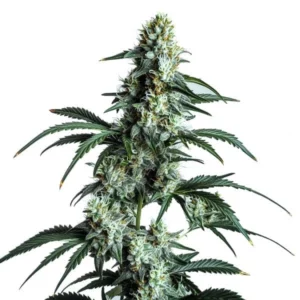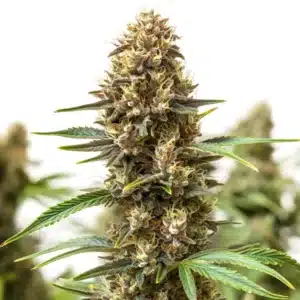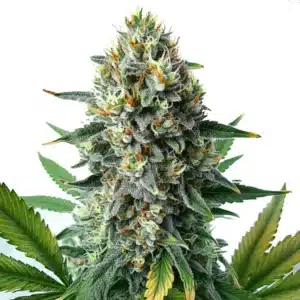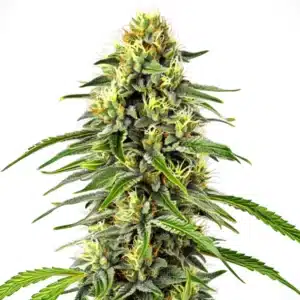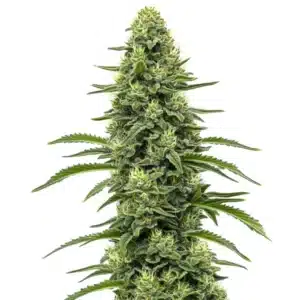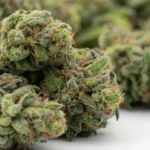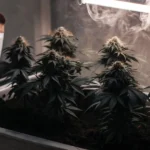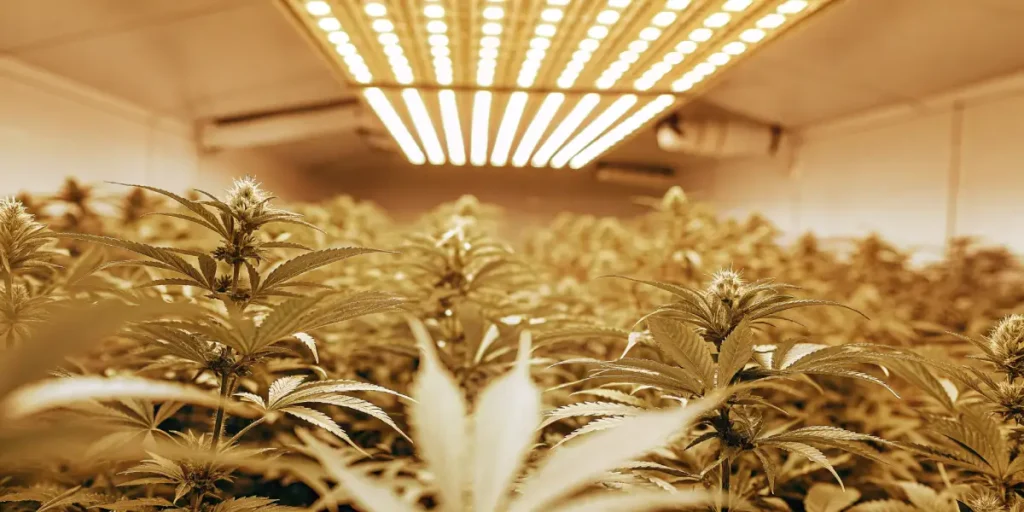
Optimizing Transpiration in Your Cannabis Grow Room
Getting the most out of your cannabis grow room involves mastering the art of optimizing transpiration. Transpiration is the process where plants release water vapor through small pores in their leaves. For cannabis, this is crucial as it affects nutrient uptake, growth rate, and overall plant health.
Think of transpiration as the plant’s way of breathing. When done right, it helps in improving cannabis plant transpiration efficiency. A well-balanced environment encourages healthy growth and maximizes yield. Let’s dive into some practical ways to enhance transpiration in your grow room.
Recommended Strains
Sour Diesel
|
|
THC | 22% - 25% (Medium) |
|
|
Type | Feminized |
|
|
Yield | High |
|
|
Phenotype | 30% Indica / 70% Sativa |
Grizzly Purple Kush
|
|
THC | 15% - 20% (Medium) |
|
|
Type | Feminized |
|
|
Yield | High |
|
|
Phenotype | 70% Indica / 30% Sativa |
When setting up your grow room, pay close attention to how you control humidity for cannabis transpiration. Humidity levels directly impact how much water your plants release. Too much or too little can stress the plants, affecting their growth.
Controlling Humidity for Cannabis Transpiration
Humidity control is essential. High humidity can lead to mold, while low humidity may cause the plants to close their pores, slowing down transpiration. Aim for a humidity level of 40-60% during the flowering stage. This balance helps in preventing mold and encourages proper water movement in the plant.
Using a hygrometer will help you monitor the humidity levels in your grow room. If you find the air too dry, consider using a humidifier. Conversely, a dehumidifier can help if the air is too moist. Regular monitoring ensures that your plants are transpiring efficiently.
Additionally, controlling humidity for cannabis transpiration involves knowing the specific needs of your plant strains. Some strains may prefer slightly higher or lower humidity levels, so it’s important to adjust accordingly. By maintaining the ideal humidity, you ensure the plants can breathe and grow optimally.
Another practical tip is to group plants with similar humidity requirements together. This makes it easier to manage the environment and ensures consistent conditions for optimizing transpiration in your cannabis grow room. Grouping plants can also help prevent cross-contamination of pests and diseases.
Balancing Temperature for Cannabis Transpiration
Temperature plays a significant role in transpiration. Cannabis plants thrive in temperatures between 70-85°F (21-29°C). If temperatures soar, your plants might release more water than they can take up, leading to dehydration. Cooler temperatures can slow down the transpiration process.
Using fans and air conditioning can help maintain optimal temperatures. Position fans to circulate air evenly throughout the grow room. This not only helps in balancing temperature for cannabis transpiration but also prevents any hot spots that could harm the plants.
Balancing temperature for cannabis transpiration also involves knowing the diurnal temperature variation—how temperatures fluctuate between day and night. Gradual changes are less stressful for plants and help maintain stable transpiration rates, which is crucial for plant health and yield.
Besides, consider the heat generated by grow lights. LED lights generally produce less heat compared to HID or fluorescent lights, making them a practical choice for maintaining ideal temperatures. Adjusting light cycles and distances can also help keep the environment stable.
Promos & Deals
Optimizing Airflow in Cannabis Grow Room
Airflow is crucial for healthy transpiration. Stagnant air can lead to mold and pests, which can quickly ruin your crop. Proper airflow ensures that your plants are well-ventilated, allowing them to transpire efficiently.
Install oscillating fans to keep air moving around your plants. Make sure the air is not blowing directly onto the plants but rather circulating the room. This creates a gentle breeze, mimicking outdoor conditions, which is ideal for plant growth.
Optimizing airflow in a cannabis grow room involves not just the use of fans, but also ensuring adequate ventilation. This means having intake and exhaust systems to bring in fresh air and remove stale air. Proper ventilation helps maintain optimal oxygen and carbon dioxide levels, essential for plant respiration.
Another aspect of optimizing airflow is arranging plants in a way that prevents overcrowding. This allows air to circulate freely around each plant, reducing the risk of moisture build-up and promoting better transpiration rates.
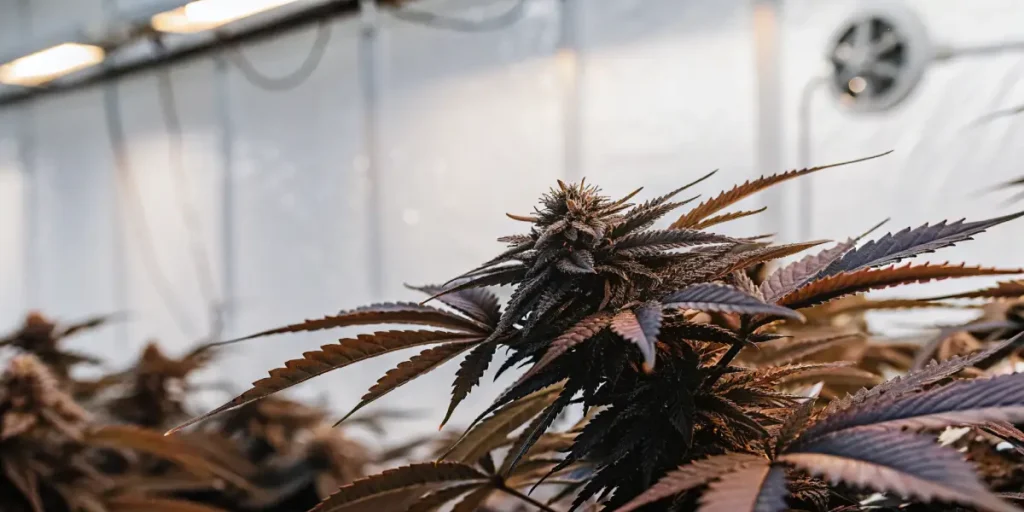
Enhancing Water Uptake in Cannabis Cultivation
Water uptake is directly linked to transpiration. When plants transpire, they create a vacuum that pulls water from the roots. Improving this process can significantly enhance water uptake in cannabis cultivation.
Ensure your plants are well-watered but not overwatered. Overwatering can lead to root rot, while underwatering can stress the plants. A simple way to check is by sticking your finger an inch into the soil. If it’s dry, it’s time to water.
Enhancing water uptake in cannabis cultivation also involves choosing the right soil or growing medium. A medium that retains adequate moisture while allowing for good drainage is ideal. This balance prevents waterlogging and ensures roots have access to oxygen, both crucial for healthy growth.
Additionally, consider incorporating mycorrhizal fungi in your growing medium. These beneficial fungi enhance the root system’s ability to absorb water and nutrients, effectively improving cannabis plant transpiration efficiency and overall health.
Using Technology to Aid Transpiration
Modern technology can assist in optimizing transpiration in your cannabis grow room. Using tools like digital thermometers, hygrometers, and automated watering systems can make maintaining the perfect environment easier.
These tools provide real-time data, allowing you to make quick adjustments. Automated systems can even be set to water your plants at specific intervals, ensuring consistent hydration and transpiration.
Technology can further aid in optimizing transpiration by integrating environmental control systems. These systems can automate climate conditions, adjusting temperature, humidity, and airflow based on real-time data, ensuring a stable environment for your plants.
By leveraging technology, you can achieve a higher level of precision in your grow room management. This precision is key to improving cannabis plant transpiration efficiency, as it allows for fine-tuning of conditions to meet the specific needs of your plants.
Practical Tips for First-Time Growers
Starting out as a first-time grower can seem daunting. Focus on the basics: humidity, temperature, and airflow. These elements are the pillars of a successful grow room setup.
Don’t overwhelm yourself with too many plants at first. Start with a few and learn their needs. As you become more familiar with the process, you can gradually increase your plant count.
Another practical tip is to document your growing process. Keeping a journal of environmental conditions and plant responses helps you track what works and what doesn’t, aiding in optimizing transpiration in your cannabis grow room over time.
Experiment with different strains to find out which ones suit your growing conditions best. Starting with robust strains can build your confidence and provide a solid foundation for learning the nuances of cannabis cultivation.

FAQ Section
How does humidity affect transpiration in cannabis plants?
Humidity levels are critical for cannabis transpiration. High humidity levels can reduce a plant’s ability to release water vapor, leading to issues like mold and mildew. Conversely, low humidity can cause the plant to transpire more aggressively, potentially causing dehydration.
Maintaining a balanced humidity level helps ensure that your plants can effectively manage water and nutrient uptake. Using tools like humidifiers and dehumidifiers can help you achieve the desired humidity range, ensuring optimal growth conditions.
Knowing the specific humidity needs of different growth stages is also important. Seedlings, vegetative, and flowering stages may each require different humidity levels to optimize transpiration and growth.
Regularly calibrating your humidity control devices ensures they provide accurate readings. Consistency in humidity management is key to preventing stress and promoting healthy plant development.
What role does temperature play in the transpiration process?
Temperature significantly influences transpiration rates. In warmer environments, plants may transpire more quickly, which can lead to faster nutrient uptake but also increase the risk of dehydration if not monitored closely.
Keeping temperatures within the ideal range for cannabis—70-85°F—helps maintain a balance where the plant can transpire efficiently without losing too much water. This balance is crucial for maintaining plant health and optimizing growth.
Temperature management should also consider the impact of external weather conditions if growing indoors. Seasonal changes can affect indoor temperatures, so adjustments may be needed to maintain optimal transpiration conditions year-round.
Utilizing climate control systems that provide consistent heating or cooling can help manage temperature fluctuations, ensuring that your grow room maintains the ideal conditions for cannabis transpiration.
Why is airflow important in a grow room?
Airflow is essential because it prevents the build-up of moisture and heat around the plants, which can lead to mold and pest problems. Proper airflow ensures that the air is constantly moving, helping to regulate temperature and humidity.
Using oscillating fans to create a gentle breeze can mimic natural outdoor conditions, providing a healthier environment for the plants. This setup encourages better transpiration and overall plant vigor.
Airflow also plays a role in strengthening plant stems, as the gentle movement mimics natural wind conditions. Strong stems support heavier yields, contributing to better overall plant health and productivity.
Regularly inspect and maintain your ventilation equipment to ensure it’s functioning efficiently. Clean filters and fans to prevent dust build-up, which can hinder airflow and reduce system effectiveness.
How can technology assist in optimizing transpiration?
Technology offers tools like automated watering systems, digital hygrometers, and thermostats, making it easier to maintain optimal conditions in your grow room. These systems provide real-time data, helping you make informed decisions about watering and environmental adjustments.
Automated systems can be particularly beneficial for beginners, taking the guesswork out of maintaining a consistent environment. This consistency is key to ensuring your plants transpire efficiently and grow robustly.
Incorporating smart technology, such as apps that monitor and control grow room conditions remotely, can provide added convenience and precision in managing your grow room environment.
Technology allows for data analysis over time, enabling growers to identify patterns and make data-driven decisions to improve cannabis plant transpiration efficiency and yield outcomes.
What are the best cannabis strains for first-time growers focusing on transpiration?
First-time growers should consider strains that are known for their resilience and adaptability, such as Sour Diesel or Grizzly Purple Kush. These strains are forgiving and can handle minor environmental fluctuations, making them ideal for learning about transpiration optimization.
Choosing strains that are easy to grow allows beginners to focus on mastering the basics of plant care, including managing humidity, temperature, and airflow, without the added stress of maintaining a more demanding strain.
When selecting strains, consider those that have a reputation for consistent performance in various conditions, which can provide a more forgiving learning curve for new growers.
By starting with robust strains, first-time growers can build confidence and refine their skills in optimizing transpiration in your cannabis grow room, setting the stage for future cultivation success.


